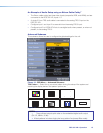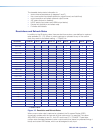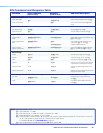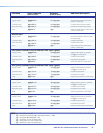
Symbol Definitions
• = Space
] = Carriage return with line feed
¦ or} = Carriage return with no line feed
E
or W = Escape
14
= Superscripts indicate the error message displayed if the command is entered incorrectly or
with invalid parameters. See “Error Response References” on page 21.
X! = Input selection, 1-3
X@ = Output selection, 1 = HDMI
X# = Input video format:
1 = RGB
2 = YUV
3 = Composite
4 = HDMI
X$ = Horizontal or vertical start — 0 to 255 (default midpoint = 128)
X% = Pixel phase — 0 to 63 (default = 31)
X^ = Total pixels — (±512 of the default value)
X& = Active pixels — (±512 of the default value)
X* = Active lines — (±256 of the default value)
X( = Enable or disable; 0 = Off or disable, 1 = On or enable
X1) = Input standard:
0 = No signal detected 3 = NTSC 4.43
1 = NTSC 3.85 4 = SECAM
2 = PAL
- = N/A (occurs when input is an active RBG, YUV [but not NTSC/PAL], or HDMI signal
X1! = Internal temperature (in degrees Celsius)
X1@ = Horizontal and vertical frequencies (format is three-digit with single decimal and leading zeros
for example, 075.3
)
X1# = Text label or preset name: up to 16 characters
NOTE: User and input presets saved without a name are saved with the default names
“User Preset xx” (for example, User Preset 12) or Input Preset xxx (for example
Input Preset 006).
X1$ = Picture adjustment — 0 to 127 (default 64)
X1% = Horizontal and vertical position, range depends on resolution, with leading “+” or “-”,
for example, “-1075”
X1^ = Horizontal and vertical size, range range depends on resolution
DSC 301 HD • SIS Communication and Control 22


















